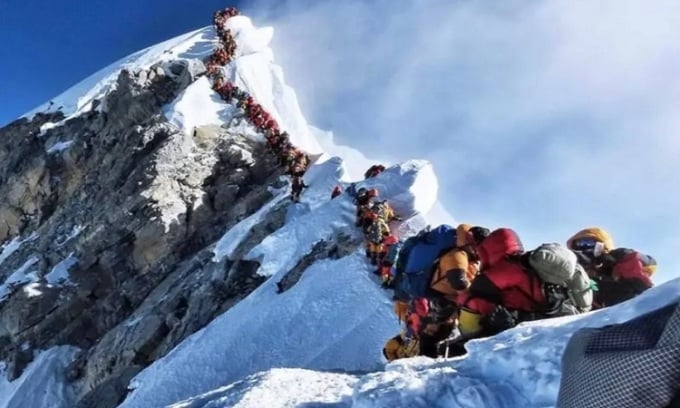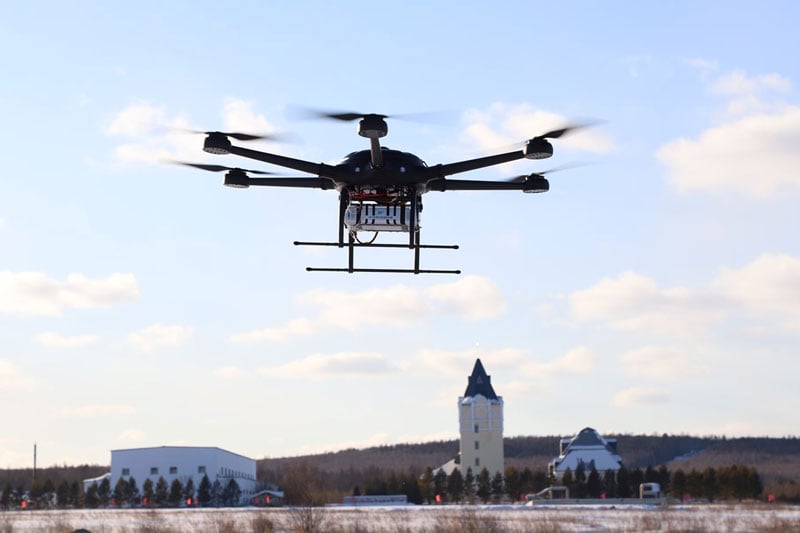Climbers often face hellish conditions when trying to cross the "death zone" at altitudes above 8,000m, where there is so little oxygen that the body begins to die minute by minute.

Crowds of people trying to climb Mount Everest. Photo: Business Insider
The human body functions best at sea level, when oxygen levels are right for the brain and lungs. At higher altitudes, the human body cannot function properly. But if you want to conquer Mount Everest, the world's tallest mountain at 8,848 meters, climbers must cross the "death zone," according to Business Insider .
In the death zone, climbers’ brains and lungs are starved of oxygen, increasing their risk of heart attacks and strokes, which can quickly affect their ability to make decisions. It’s a race against time, says Shaunna Burke, who climbed Everest in 2005. In May 2023, a 50-year-old climber from China collapsed at 8,230m and suffered frostbite. Her equipment became tangled in a rope and her oxygen tank ran out. She survived after being found and rescued by two other climbers. Still, at least 12 people have died on Everest this year, making 2023 one of the deadliest climbing seasons on record.
At sea level, the air contains 21 percent oxygen. But above 12,000 feet, it is 40 percent less. Jeremy Windsor, a doctor who climbed Everest in 2007 as part of the Caudwell Xtreme expedition, said blood samples taken from four climbers in the death zone revealed they were surviving on a quarter of the oxygen they would at sea level, the equivalent of a dying patient. At 5,000 feet above sea level, the air contains so little oxygen that even with oxygen tanks, it feels like running on a treadmill and breathing through a straw. Hypoxia leads to a host of health risks. When the amount of oxygen in the blood drops below a certain level, the heart rate increases to 140 beats per minute, increasing the risk of a heart attack.
Climbers must allow their bodies time to adapt to the lung-crushing conditions of the Himalayas before attempting to summit Everest. Expeditions typically involve at least three stages of ascent from Everest base camp (which is taller than most European mountains at 17,500 feet), ascending several hundred feet in each stage before reaching the summit. After weeks at high altitude, the body begins to produce more hemoglobin (the protein in red blood cells that carries oxygen from the lungs to the rest of the body). But too much hemoglobin can thicken the blood, making it harder for the heart to pump blood throughout the body. That can lead to a stroke or fluid buildup in the lungs.
On Everest, a condition called high-altitude pulmonary edema (HAPE) is common, with symptoms including fatigue, feeling breathless at night, weakness, and a persistent cough. Sometimes the cough is so severe that it can crack ribs. Climbers with HAPE have trouble breathing, even when lying down.
Acclimatization to high altitudes in the death zone is not possible, according to Dr. Peter Hackett. One of the biggest risks at 25,000 feet is hypoxia, which prevents oxygen from circulating properly to organs like the brain. Without enough oxygen, the brain can begin to swell, causing high-altitude cerebral edema (HACE), which can cause dizziness, vomiting, and difficulty thinking. The lack of oxygen to the brain can cause climbers to forget where they are and become delirious. Their decision-making ability is affected, leading to strange behaviors like undressing or talking to imaginary friends.
Burke says she developed a persistent cough while climbing. The air was so thin that she couldn’t sleep. “People start to lose strength. Sleep becomes a problem. Muscle atrophy and weight loss sets in,” Hackett says. Dizziness and nausea from altitude sickness, such as HAPE and HACE, also reduce appetite. The endless whiteness of the snow and ice can cause snowshoeing. Poor circulation to a climber’s fingers and toes can lead to frostbite and, in more severe cases, gangrene. Gangrene often requires amputation.
Climbing in the death zone is a “living hell,” according to Everest climber and 1998 NOVA expedition member David Carter. Typically, climbers attempt to summit and descend in a single day, spending as little time in the death zone as possible before returning to safer altitudes.
An Khang (According to Business Insider )
Source link




![[Photo] Overcoming all difficulties, speeding up construction progress of Hoa Binh Hydropower Plant Expansion Project](https://vstatic.vietnam.vn/vietnam/resource/IMAGE/2025/4/12/bff04b551e98484c84d74c8faa3526e0)


![[Photo] Closing of the 11th Conference of the 13th Central Committee of the Communist Party of Vietnam](https://vstatic.vietnam.vn/vietnam/resource/IMAGE/2025/4/12/114b57fe6e9b4814a5ddfacf6dfe5b7f)
























































































Comment (0)